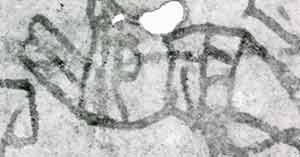
Handy Links
SLAC News Center
SLAC Today
- Subscribe
- Archives: Feb 2006-May 20, 2011
- Archives: May 23, 2011 and later
- Submit Feedback or Story Ideas
- About SLAC Today
SLAC News
Lab News
- Interactions
- Lightsources.org
- ILC NewsLine
- Int'l Science Grid This Week
- Fermilab Today
- Berkeley Lab News
- @brookhaven TODAY
- DOE Pulse
- CERN Courier
- DESY inForm
- US / LHC
SLAC Links
- Emergency
- Safety
- Policy Repository
- Site Entry Form

- Site Maps
- M & O Review
- Computing Status & Calendar
- SLAC Colloquium
- SLACspeak
- SLACspace
- SLAC Logo
- Café Menu
- Flea Market
- Web E-mail
- Marguerite Shuttle
- Discount Commuter Passes
-
Award Reporting Form
- SPIRES
- SciDoc
- Activity Groups
- Library
Stanford
Around the Bay
Archimedes Returns to SSRL
In March of 2006, an x-ray beam at the Stanford Synchrotron Radiation Laboratory illuminated a 1,000-year-old manuscript that conceals the work of ancient mathematical genius Archimedes.
Pages of the manuscript first came to experimental station 6-2 at SSRL in May 2005. At that time, a research team of museum curators, x-ray scientists and an ancient mathematics historian showed it was possible to read obscured layers of text and graphics by shining x-ray light specifically tuned to make the iron pigment in the ink fluoresce. This month, the same team studied additional pages of the Archimedes manuscript to reveal more of the ancient text.
The manuscript is called a palimpsest because the original text—a 10th century copy of Archimedes' 3rd century B.C. treatises—was scrubbed nearly clean and written over with a religious text in the 13th century. Modern forgers added to the layers by painting over both texts with religious scenes on at least five pages. But faint traces of the 10th century ink remain embedded in the goat-skin parchment.
A preservation team from The Walters Art Museum in Baltimore brought seven of the most difficult pages, including the very first page of the manuscript, to SLAC several weeks ago.
Stains from the leather binding mar the bookworm-eaten page. "Itís in appalling condition," said curator Will Noel.
 Nonetheless, the x-ray imaging revealed the page's contents, including the name
of the scribe who copied
the religious text. John was his first name, he was a priest, and he finished his labors on April 14,
1229. His last name, written in ancient Greek, is still being worked out. An image of a hand (see left) points
toward the first line of prayer text and might also have served as a blessing on the text.
Nonetheless, the x-ray imaging revealed the page's contents, including the name
of the scribe who copied
the religious text. John was his first name, he was a priest, and he finished his labors on April 14,
1229. His last name, written in ancient Greek, is still being worked out. An image of a hand (see left) points
toward the first line of prayer text and might also have served as a blessing on the text.
The researchers also looked at three page "stubs," the part left in a book when a page is ripped out. One of the stubs contains Archimedes' text and a fragment of a diagram.
In addition, the team studied pages with religious scenes painted by 20th century forgers unaware of the Archimedes text underneath. SSRL scientists are working out ways to get better images of the texts buried beneath the paintings. This time, they took images from the backside of the page, and measured fluorescence from other elements like zinc and barium that were found in the paint pigment but not in the ink. This helps to determine if a mark is just paint or if it is paint with text underneath.
Two of the forged paintings cover parts of the only surviving copy of Archimedes' The Method, in which Archimedes showed how he arrived at his mechanical theorem as well as certain other theorems. The team is now analyzing the data to continue reading the text, and hopes to bring different parts of the palimpsest back to SSRL in July.
"All in all, it was a fantastic run and we have provided good images to the scholars to work on," said Uwe Bergmann of SSRL.
The story of SSRL's x-rays revealing parts of the Archimedes palimpsest was the top lightsources.org news story of 2005, based on press coverage.
—Heather Rock Woods
SLAC Today, March 22, 2006